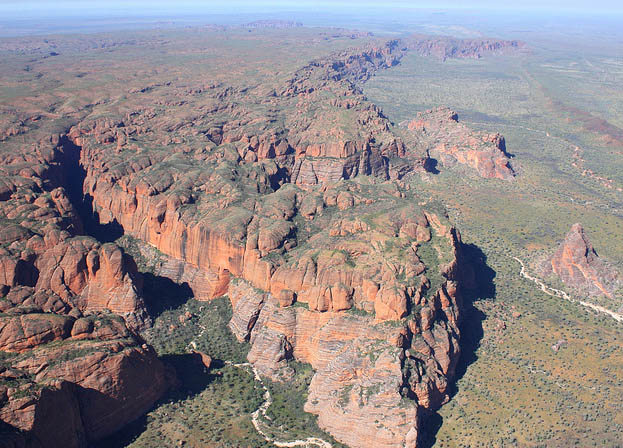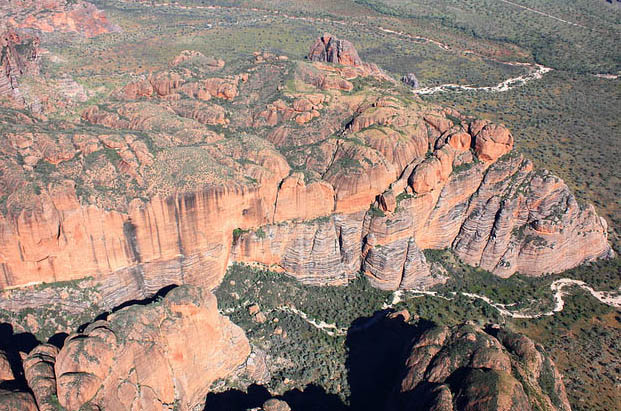Purnululu National Park
Peble Jeine
The 239,723 ha Purnululu National Park is located in the State of Western Australia. It contains the deeply dissected Bungle Bungle Range composed of Devonian-age quartz sandstone eroded over a period of 20 million years into a series of beehive-shaped towers or cones, whose steeply sloping surfaces are distinctly marked by regular horizontal bands of dark-grey cyanobacterial crust (single-celled photosynthetic organisms). These outstanding examples of cone karst owe their existence and uniqueness to several interacting geological, biological, erosional and climatic phenomena.
 |
| Cathedral Gorge, Purnululu National Park |
Earth’s history and geological features The claim to outstanding universal geological value is made for the Bungle Bungle Range. The Bungle Bungles are, by far, the most outstanding example of cone karst in sandstones anywhere in the world and owe their existence and uniqueness to several interacting geological, biological, erosional and climatic phenomena. The sandstone karst of PNP is of great scientific importance in demonstrating so clearly the process of cone karst formation on sandstone - a phenomenon recognised by geomorphologists only over the past 25 years and still incompletely understood, despite recently renewed interest and research. The Bungle Bungle Ranges of PNP also display to an exceptional degree evidence of geomorphic processes of dissolution, weathering and erosion in the evolution of landforms under a savannah climatic regime within an ancient, stable sedimentary landscape. IUCN considers that the nominated site meets this criterion.
Superlative natural phenomena or natural beauty and aesthetic importance Although PNP has been widely known in Australia only during the past 20 years and it remains relatively inaccessible, it has become recognised internationally for its exceptional natural beauty. The prime scenic attraction is the extraordinary array of banded, beehive-shaped cone towers comprising the Bungle Bungle Range. These have become emblematic of the park and are internationally renowned among Australia’s natural attractions. The dramatically sculptured structures, unrivalled in their scale, extent, grandeur and diversity of forms anywhere in the world, undergo remarkable seasonal variation in appearance, including striking colour transition following rain. The intricate maze of towers is accentuated by sinuous, narrow, sheer-sided gorges lined with majestic Livistona fan palms. These and the soaring cliffs up to 250 m high are cut by seasonal waterfalls and pools, creating the major tourist attractions in the park, with evocative names such as Echidna Chasm, and Frog Hole, Piccaninny and Cathedral Gorges. The diversity of landforms and ecosystems elsewhere in the park are representative of the larger region, and lack a unique aesthetic quality, but provide a sympathetic visual buffer for the massif. The powerful aesthetic experience of the Bungle Bungles has aroused huge interest among the public, and the ranges figure prominently in national and international advertising of Australia’s tourist attractions, matching the prominence of the Uluru-Kata Tjuta National Park. Photographers and travel writers include the Bungle Bungles among the world’s natural wonders, some describing them as Australia’s equivalent of the Grand Canyon.
Purnululu National Park is located in the East Kimberley Region of Western Australia located 300 km by road south of Kununurra in Western Australia's Ord Region; the listed area is almost 240,000 ha. There is an adjacent buffer zone to the north and west (the Purnululu Conservation Zone) of approximately 79,600 ha, which is not part of the nominated area. The park comprises four major ecosystems: the Bungle Bungle Mountain Range, a deeply dissected plateau that dominates the centre of the park; wide sand plains surrounding the Bungle Bungles; the Ord River valley to the east and south of the park; and limestone ridges and ranges to the west and north of the park.
The Bungle Bungle Mountains are an unusual and very dramatic plateau of Devonian quartz sandstone, created through a complex process of sedimentation, compaction, uplift (caused by the collision of Gondwanaland and Laurasia approximately 300 million years ago and the convergence of the Indo-Australian Plate and the Pacific Plate 20 million years ago), as well as long periods of erosion. The Bungle Bungle landscape comprises a mass of beehive-shaped towers with regularly alternating, dark grey bands of cynobacterial crust (single-cell photosynthetic organisms). The plateau is dissected by 100-200 m deep, sheer-sided gorges. The cone-towers are steep-sided, with an abrupt break of slope at the base and have domed summits. Their surface is fragile but stabilized by crusts of iron oxide and bacteria. They provide an outstanding example of land formation by dissolutional weathering of sandstone, with removal of sand grains by wind, rain and sheet wash on slopes.
The Bungle Bungle Range is one of the most extensive and impressive occurrences of sandstone tower karst in the world. The grassy Ord River valley on the east and south of the park is deeply incised as a result of crustal uplifting during relatively recent geological times. The wide sand plains between the uplands and the river are composed of infertile black soil covered with grassland and scattered trees. The limestone ridges to the west and Osmand Range to the north are better wooded, especially in the forested Osmand Creek valley. These rocks are believed to be of Cambrian age (550-500 million years old). There are stromatolites in the Osmand range. Purnululu also has a rich Aboriginal cultural heritage spanning over some 20,000 years. The park provides exceptional testimony to this hunter-gatherer cultural tradition, which has survived to the present day despite the impact of colonization.











Enter your first comment!